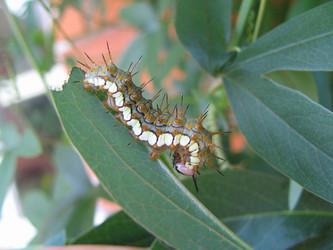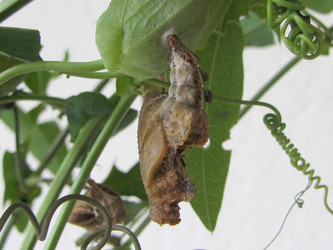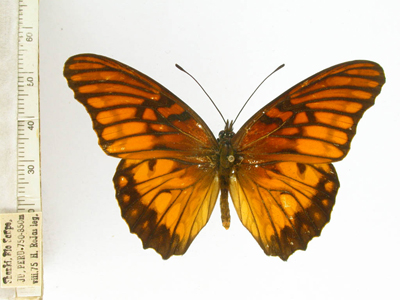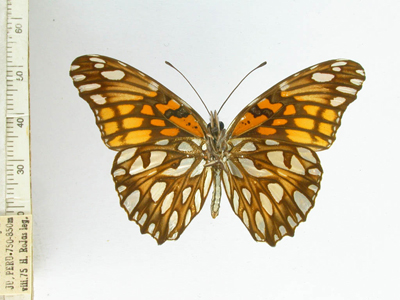Dione moneta
Margarita BeltránIntroduction
Etymology: MNEMOSYNE in Greek or MONETA in Latin was the goddess of memory and remembrance and the inventress of language and words. Mother of the Muses.
Characteristics
Early stages: Eggs are white and approximately 1.1 x 0.8 mm (h x w). Females usually place 1 to 20 eggs under leaves of the host plant. Mature larvae have a black body with yellow to green stripes and white spots, with black scoli and black and white head; length is around 1.2 cm. Caterpillars are gregarious (Brown, 1981).



Last instar larva and pupa of Dione moneta. Mexico City, Mexico. Images © Maria Franco
Habits
Dione moneta occurs in scrub and fields. Usually individuals fly rapidly. Females mate multiply, and adults roost at night in loose groups, lower than 2 m above ground on grass blades and leaves (Brown, 1981).
Hostplant: Dione moneta is polyphagous, and larvae feed primarily on plants from the subgenera Granadilla and Plectostemma (Passifloraceae) (Brown, 1981). In Costa Rica D. moneta larvae feed on Passiflora adenopoda, P. capsularis, Tetrastylis lobata (Passifloraceae) (DeVries, 1997).
References
Brown K. S. 1981 The Biology of Heliconius and Related Genera. Annual Review of Entomology 26, 427-456.
DeVries P. J. 1997 The Butterflies of Costa Rica and Their Natural History, Volume I: Papilionidae, Pieridae, Nymphalidae Princeton University Press, Baskerville, USA.
Mnemosyne. Theoi Greek Mythology. http://www.theoi.com/Titan/TitanisMnemosyne.html [Accessed 26 August 2008]
Title Illustrations

| Scientific Name | Dione moneta |
|---|---|
| Specimen Condition | Dead Specimen |
| View | dorsal |
| Collection | Gerardo Lamas |
| Image Use |
 This media file is licensed under the Creative Commons Attribution-NonCommercial-ShareAlike License - Version 3.0. This media file is licensed under the Creative Commons Attribution-NonCommercial-ShareAlike License - Version 3.0.
|
| Copyright |
©

|
| Scientific Name | Dione moneta |
|---|---|
| Specimen Condition | Dead Specimen |
| View | ventral |
| Collection | Gerardo Lamas |
| Image Use |
 This media file is licensed under the Creative Commons Attribution-NonCommercial-ShareAlike License - Version 3.0. This media file is licensed under the Creative Commons Attribution-NonCommercial-ShareAlike License - Version 3.0.
|
| Copyright |
©

|
About This Page

University of Cambridge, Cambridge, UK
Correspondence regarding this page should be directed to Margarita Beltrán at
Page copyright © 2007
 Page: Tree of Life
Dione moneta .
Authored by
Margarita Beltrán.
The TEXT of this page is licensed under the
Creative Commons Attribution-NonCommercial-ShareAlike License - Version 3.0. Note that images and other media
featured on this page are each governed by their own license, and they may or may not be available
for reuse. Click on an image or a media link to access the media data window, which provides the
relevant licensing information. For the general terms and conditions of ToL material reuse and
redistribution, please see the Tree of Life Copyright
Policies.
Page: Tree of Life
Dione moneta .
Authored by
Margarita Beltrán.
The TEXT of this page is licensed under the
Creative Commons Attribution-NonCommercial-ShareAlike License - Version 3.0. Note that images and other media
featured on this page are each governed by their own license, and they may or may not be available
for reuse. Click on an image or a media link to access the media data window, which provides the
relevant licensing information. For the general terms and conditions of ToL material reuse and
redistribution, please see the Tree of Life Copyright
Policies.
- First online 21 February 2007
- Content changed 04 September 2008
Citing this page:
Beltrán, Margarita. 2008. Dione moneta . Version 04 September 2008 (under construction). http://tolweb.org/Dione_moneta/72862/2008.09.04 in The Tree of Life Web Project, http://tolweb.org/










 Go to quick links
Go to quick search
Go to navigation for this section of the ToL site
Go to detailed links for the ToL site
Go to quick links
Go to quick search
Go to navigation for this section of the ToL site
Go to detailed links for the ToL site